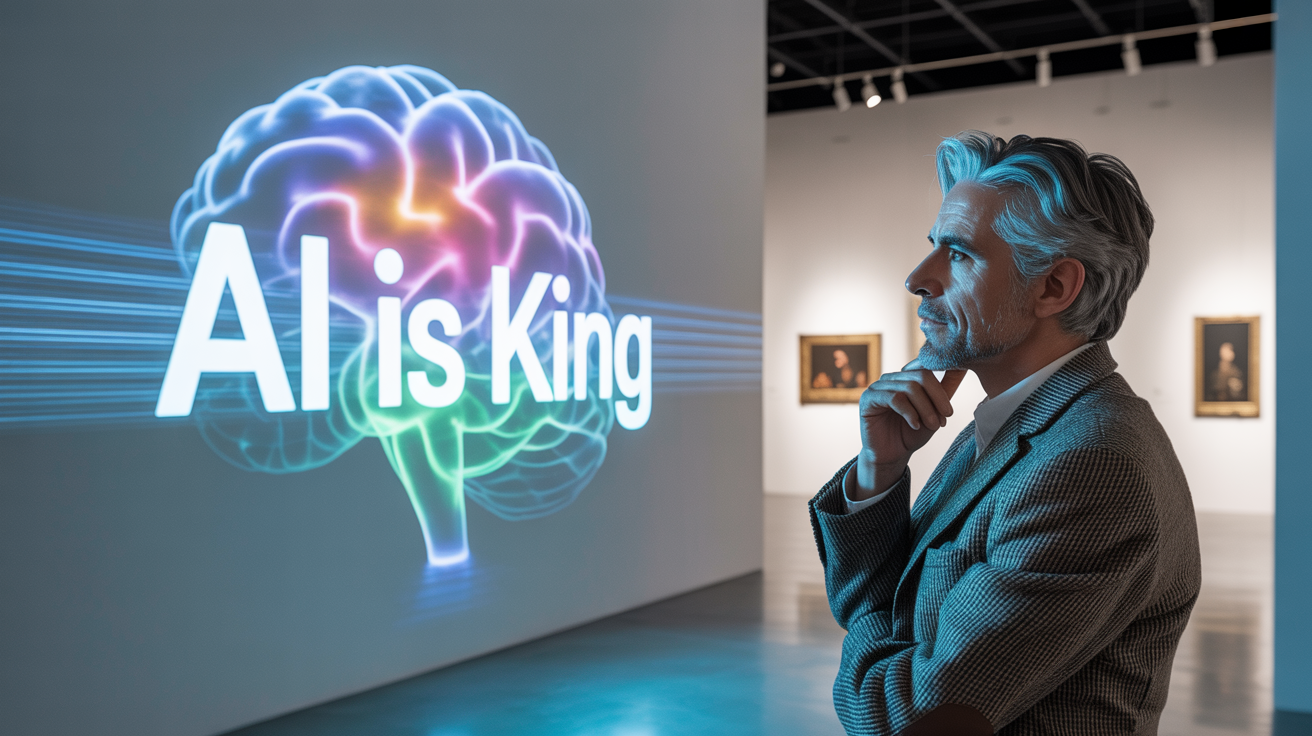AI is king: What happens to contemporary art experts?
Contemporary art is a constantly evolving field, at the crossroads between tradition and modernity, creativity and technology. With the emergence of artificial intelligence (AI), the artistic landscape is transforming at breakneck speed. At the heart of this transformation, a crucial question arises: what happens to contemporary art experts in a world where AI seems to be taking center stage? In this article, we will explore the implications of AI on the art market, the role of experts, and the new dynamics emerging in the field.
1. The rise of artificial intelligence in the art world.
Artificial intelligence is not a new concept, but its use in the field of contemporary art has grown considerably in recent years. Algorithms capable of creating artworks, predicting market trends, or even assessing the value of pieces are now available. This technological revolution raises ethical and aesthetic questions about the nature of creativity and the role of artists.
1.1. AI and artistic creation.
Artists like Mario Klingemann and Refik Anadol are using AI to create interactive works that defy convention. These creations raise the question: can machine-generated art be considered art in its own right? Contemporary art experts, like Agnès Aittouares of AB Fine Art, must now evaluate not only works created by humans, but also those produced by algorithms.
1.2. Prediction of market trends.
AI also helps us better understand the contemporary art market. Through big data analysis, it can predict trends and determine which pieces will be most valuable in the future. These analyses pose a challenge to traditional experts, who must now juggle digital data while relying on their intuition and experience.
2. The role of contemporary art experts in the age of AI.
In a world where AI is increasingly present, it is essential to ask what role contemporary art experts play. Their role is evolving, but it is far from obsolete.
2.1. Human expertise versus technology.
While AI can analyze data and generate artworks, it is no substitute for human expertise. Experts, like Agnès Aittouares, bring a contextual understanding of artworks that goes beyond mere numbers. Their ability to assess a piece's authenticity, understand its history, and contextualize its artistic significance is irreplaceable.
2.2. The importance of storytelling in art Art is above all a form of storytelling.
Experts play a crucial role in telling the story behind each work. They help collectors and buyers understand the emotional and cultural value of a piece. This storytelling is essential for building connections between artists, their works, and the public—an aspect that AI cannot replicate.
3. AB Fine Art: a partner in the world of contemporary art.
AB Fine Art, led by Agnès Aittouares, is a key player in the field of art appraisal and sales. Located in the heart of Paris, this firm offers free consultations to discuss the history and value of artworks. With over 30 years of experience, Agnès Aittouares uses her skills to analyze each piece, ensuring their authenticity and providing accurate estimates.
3.1. A complete art sales service.
AB Fine Art offers a comprehensive art sales service, collaborating with auctioneers and a network of passionate collectors. This personalized service takes into account the unique needs of each client, helping them determine the ideal time to sell and connecting them with potential buyers.
3.2. Personalized support in the transaction.
Personalized support throughout the sales process is another essential aspect of AB Fine Art's service. Experts provide assistance throughout the transaction, ensuring that each step is handled with care and professionalism. This includes preparing the artwork for sale, drafting the necessary documents, and managing buyer relationships.
4. Challenges and opportunities for contemporary art experts.
AI and new technologies pose both challenges and opportunities for contemporary art experts.
4.1. The need for continuous updating of skills.
To remain relevant, experts must constantly update their skills. This can include learning new technologies, using data analysis tools, and understanding emerging trends in the art market. Experts should also be open to collaborating with artists using AI, which can enrich their own practice.
4.2. A new approach to the evaluation of works.
AI can provide valuable insights that can complement human analysis. For example, algorithm-based appraisal tools can help determine the market value of a work based on historical data. Appraisers can then use this information to refine their estimates and provide more accurate advice to their clients.
5. Towards a hybrid future: human and machine.
The future of contemporary art appears to be moving toward a hybrid model, where humans and machines coexist to enrich the artistic experience. Contemporary art experts will have a crucial role to play in this transition.
5.1. Collaboration between experts and AI.
Collaboration between experts and AI could open new avenues for contemporary art. Experts could use data analysis tools to better understand the market and trends, while bringing their human expertise to bear on assessing the artistic and emotional value of works.
5.2. The emergence of new models of expertise.
As technologies evolve, new models of expertise could emerge. Experts could specialize in areas such as digital art or AI, bringing a new dimension to their practice. This could also include greater collaboration with artists working with innovative technologies, creating an enriching dialogue between art and science.
Conclusion :
AI is undeniably transforming the contemporary art landscape. However, this does not mean the end of art experts. On the contrary, their role is evolving, and they must adapt to this new reality. Experts like Agnès Aittouares at AB Fine Art illustrate the importance of human expertise in a world where technology is increasingly taking over. The key lies in the ability to combine tradition and innovation, using AI as a tool to enrich the understanding and appreciation of contemporary art. The future of art is promising, and those who can navigate these two worlds—human and machine—will pave the way for new collaborations and a renewed appreciation of contemporary art.

